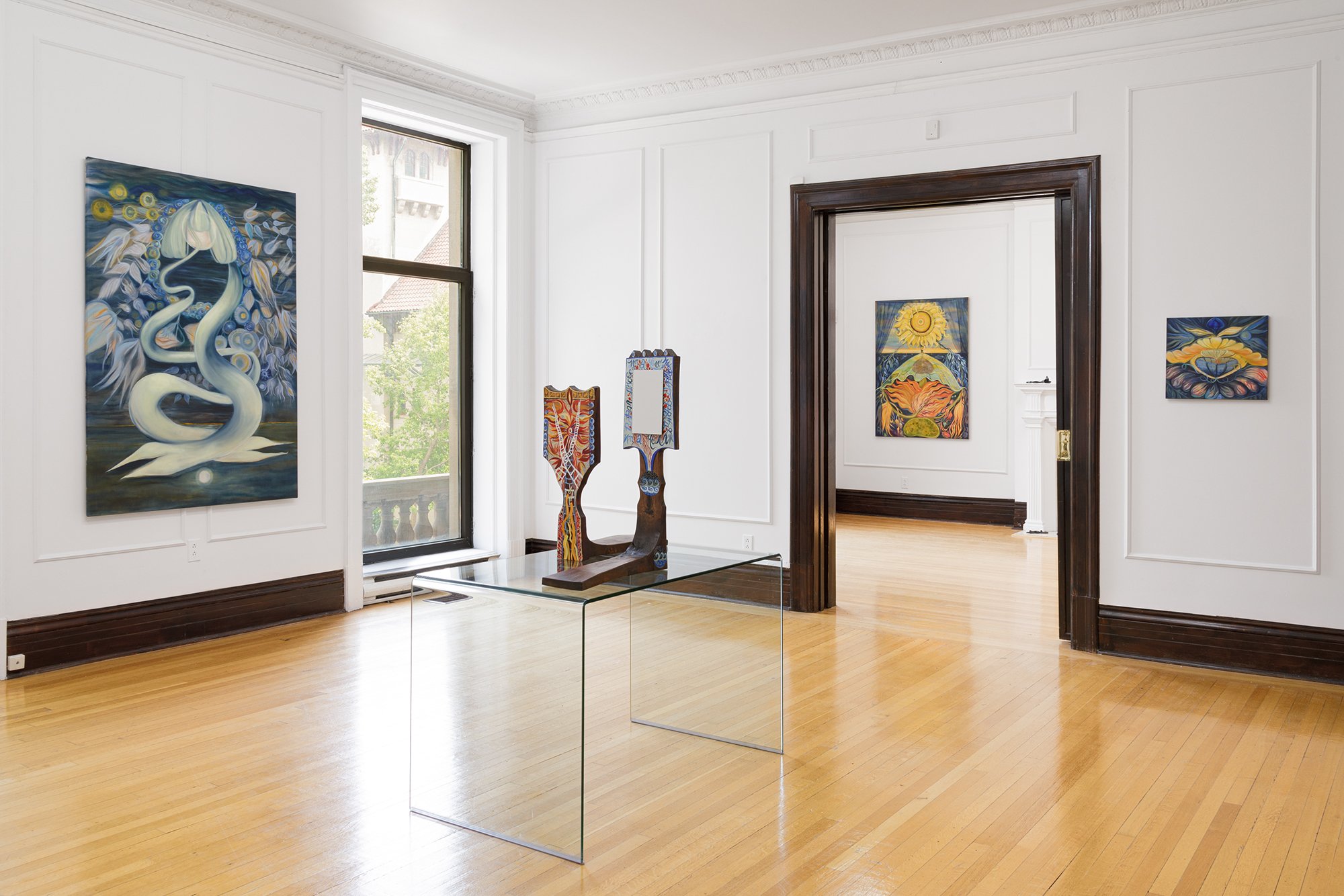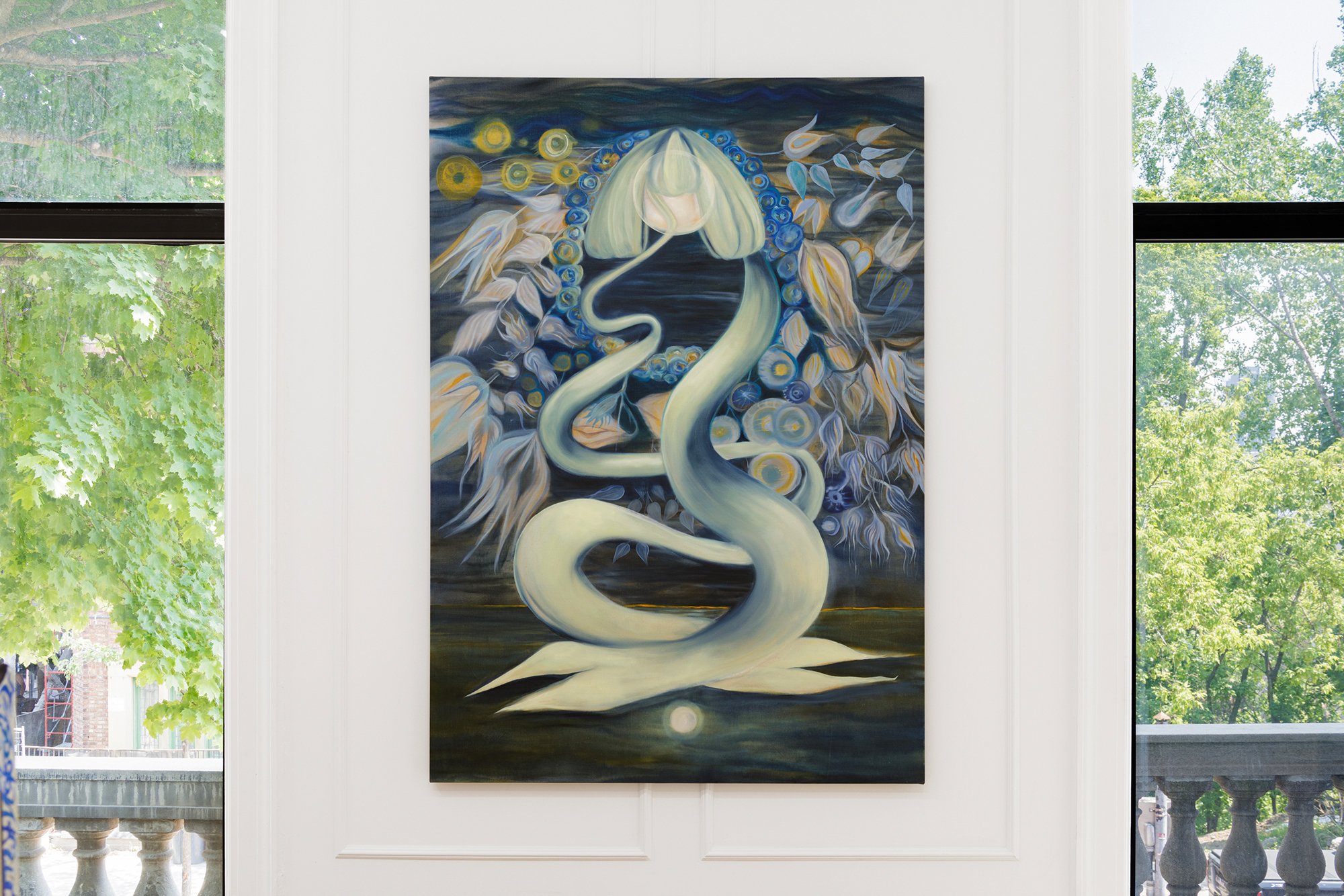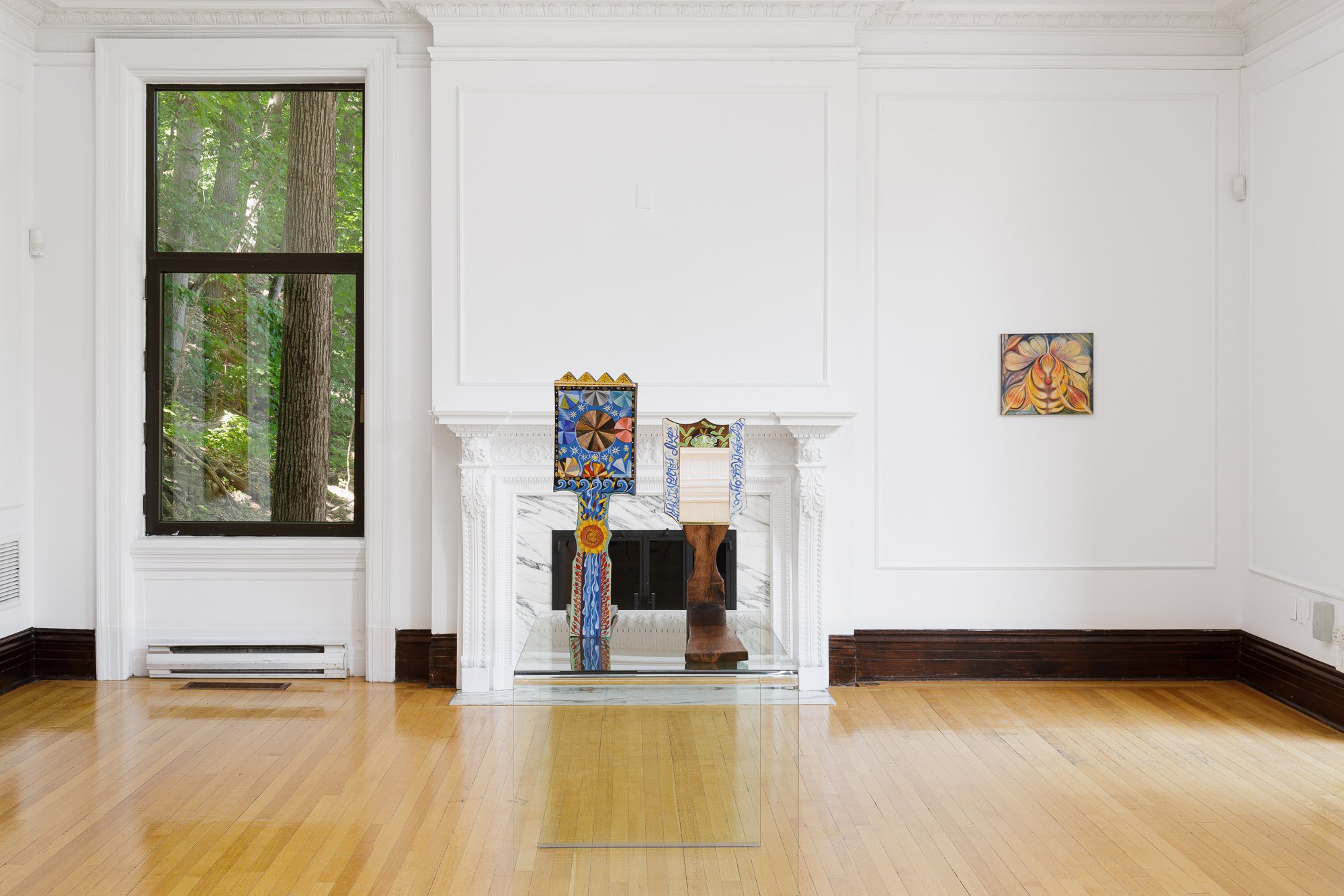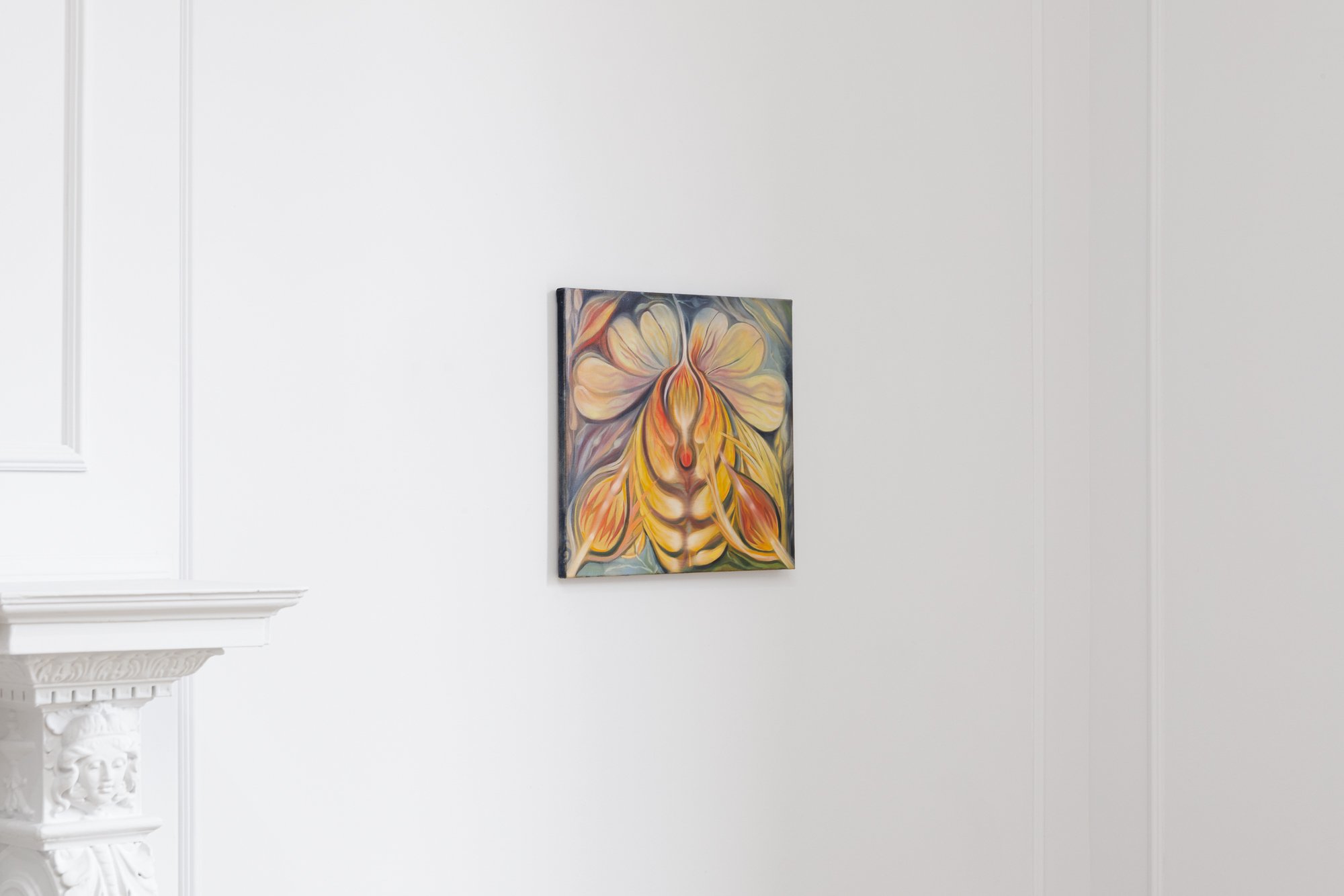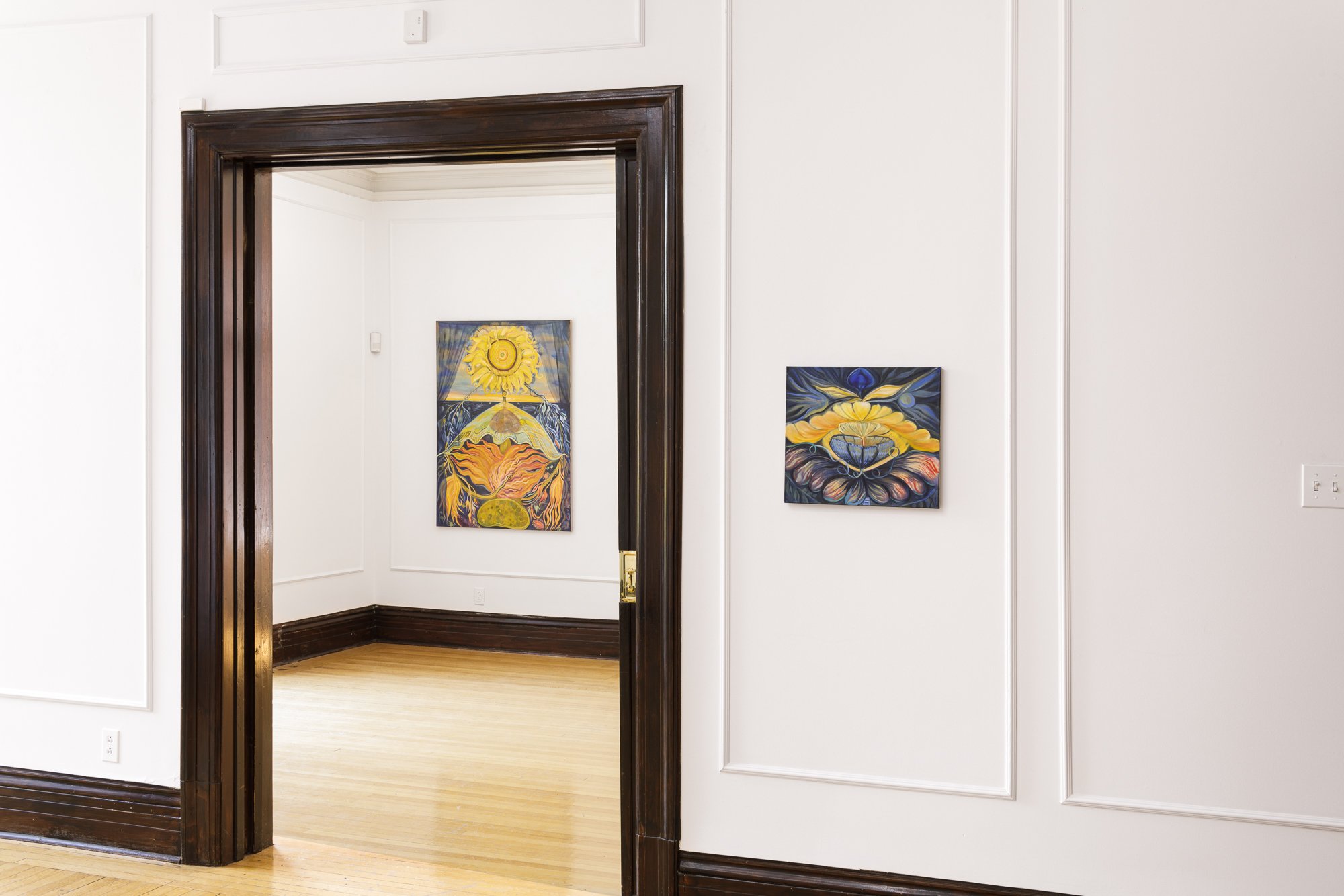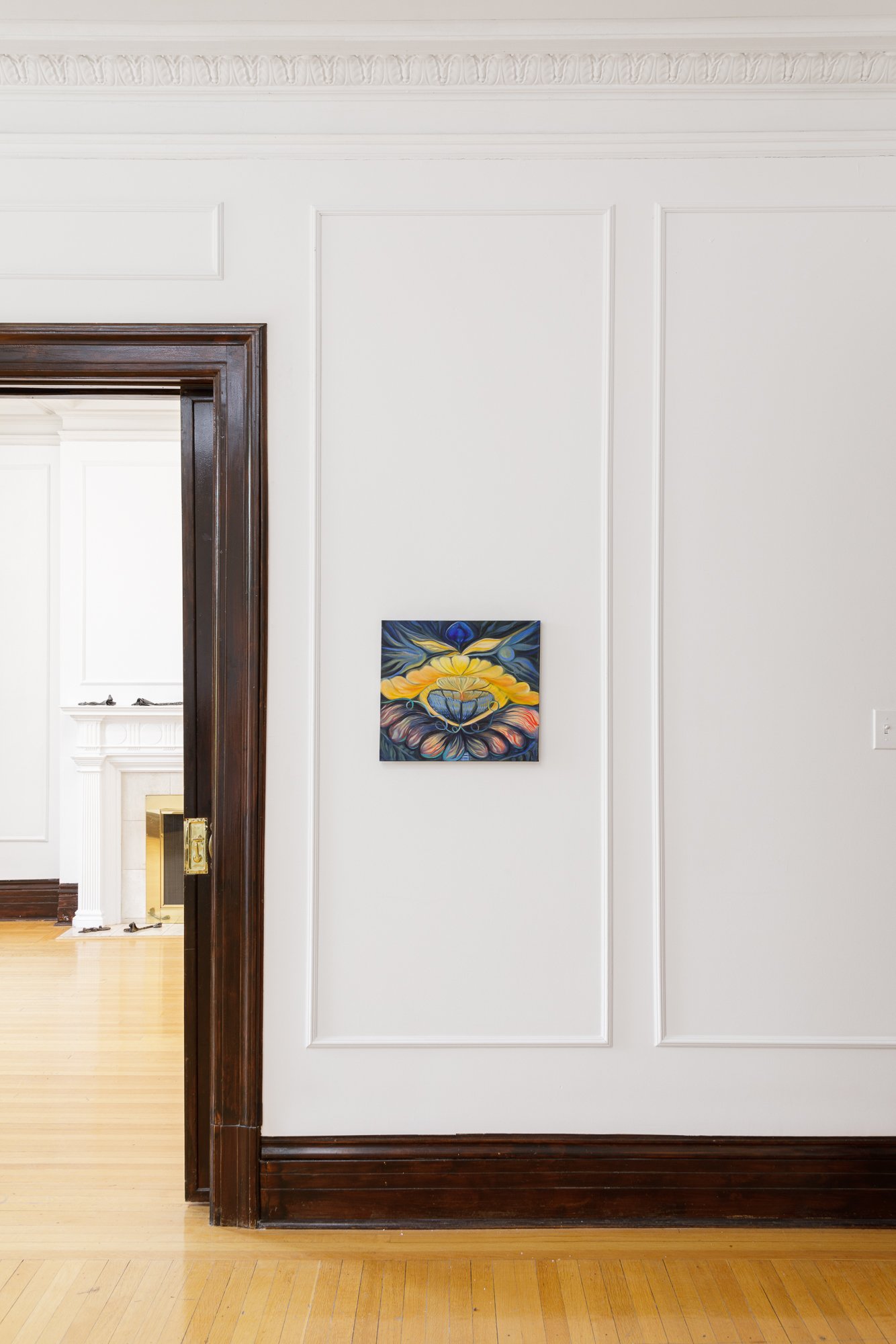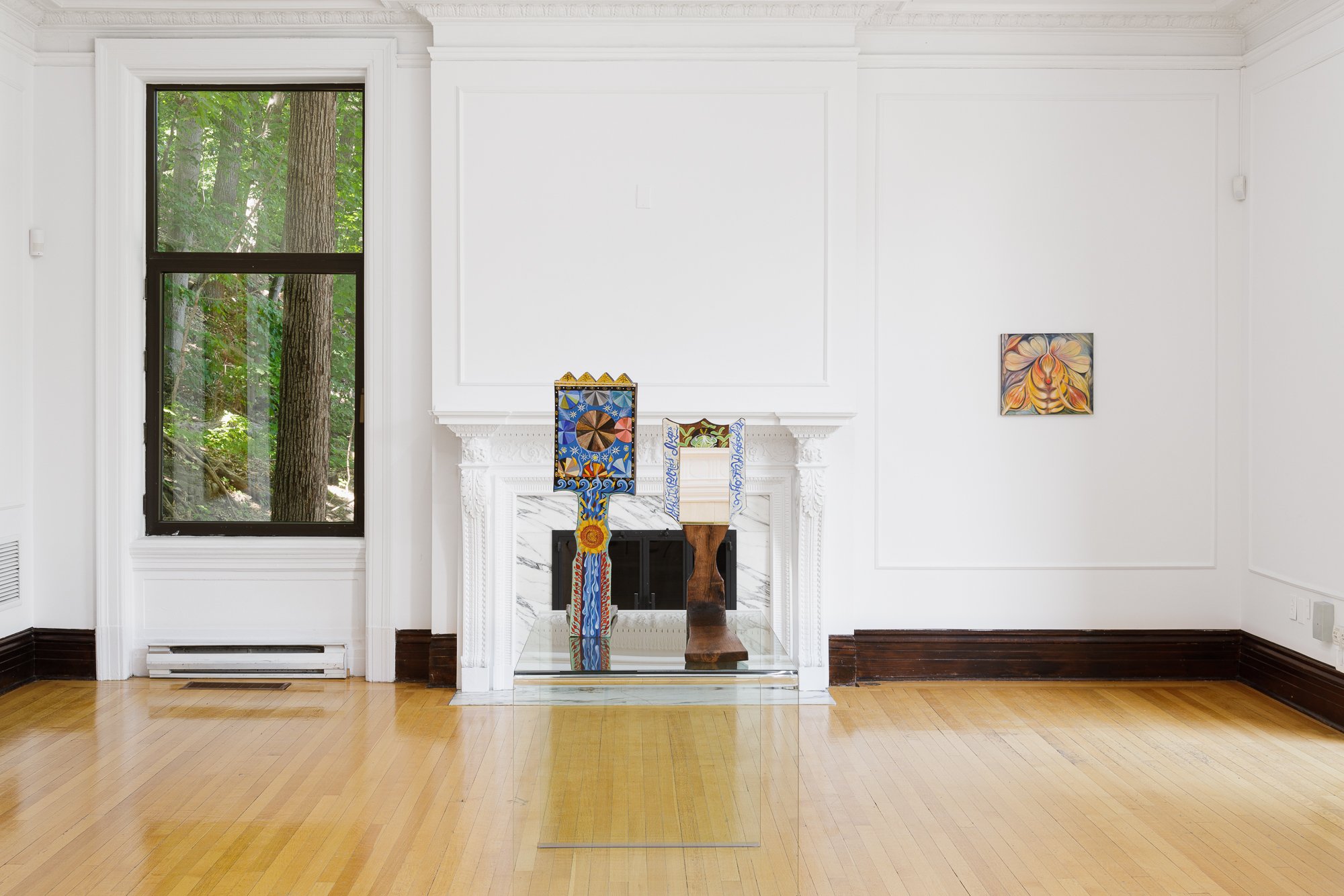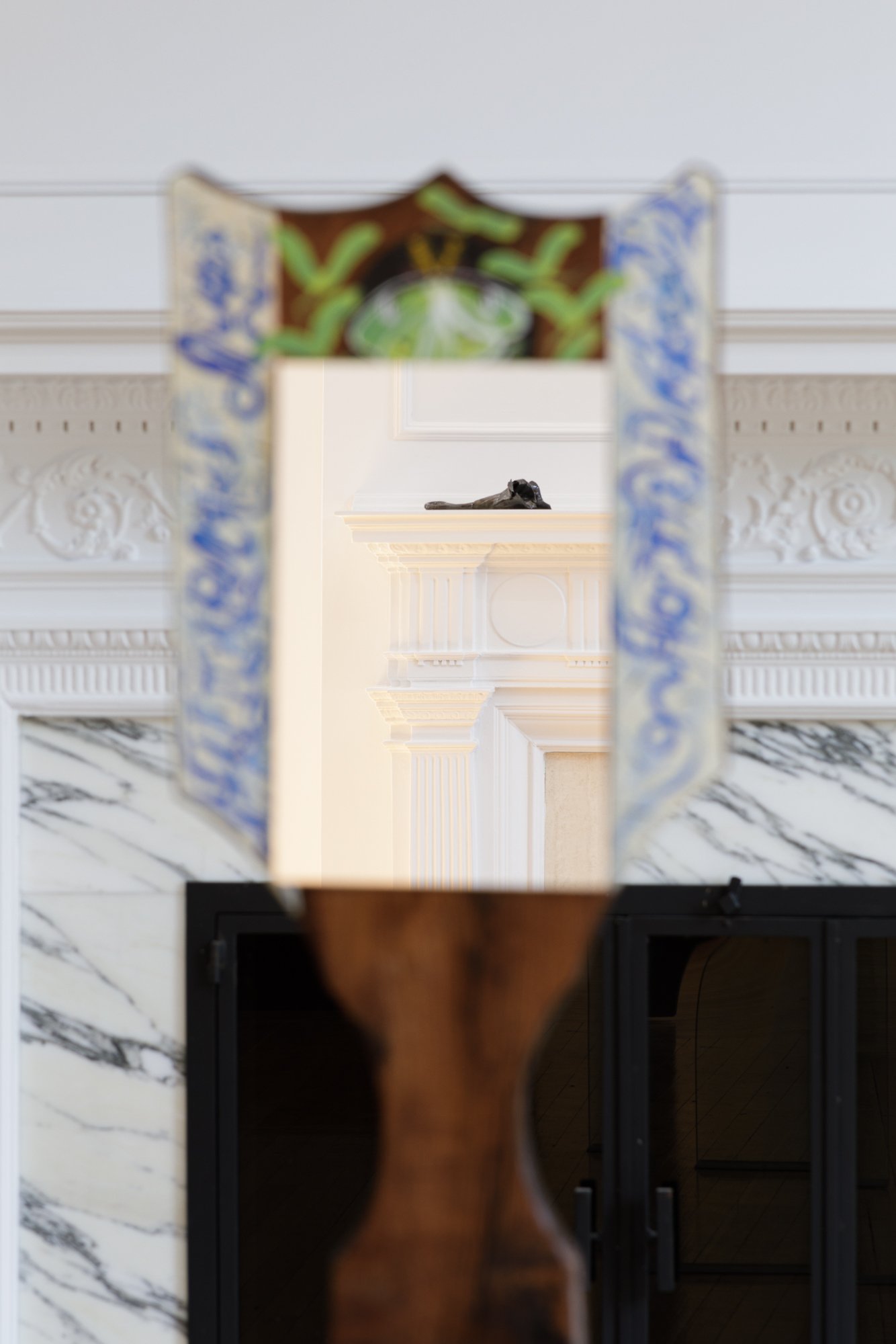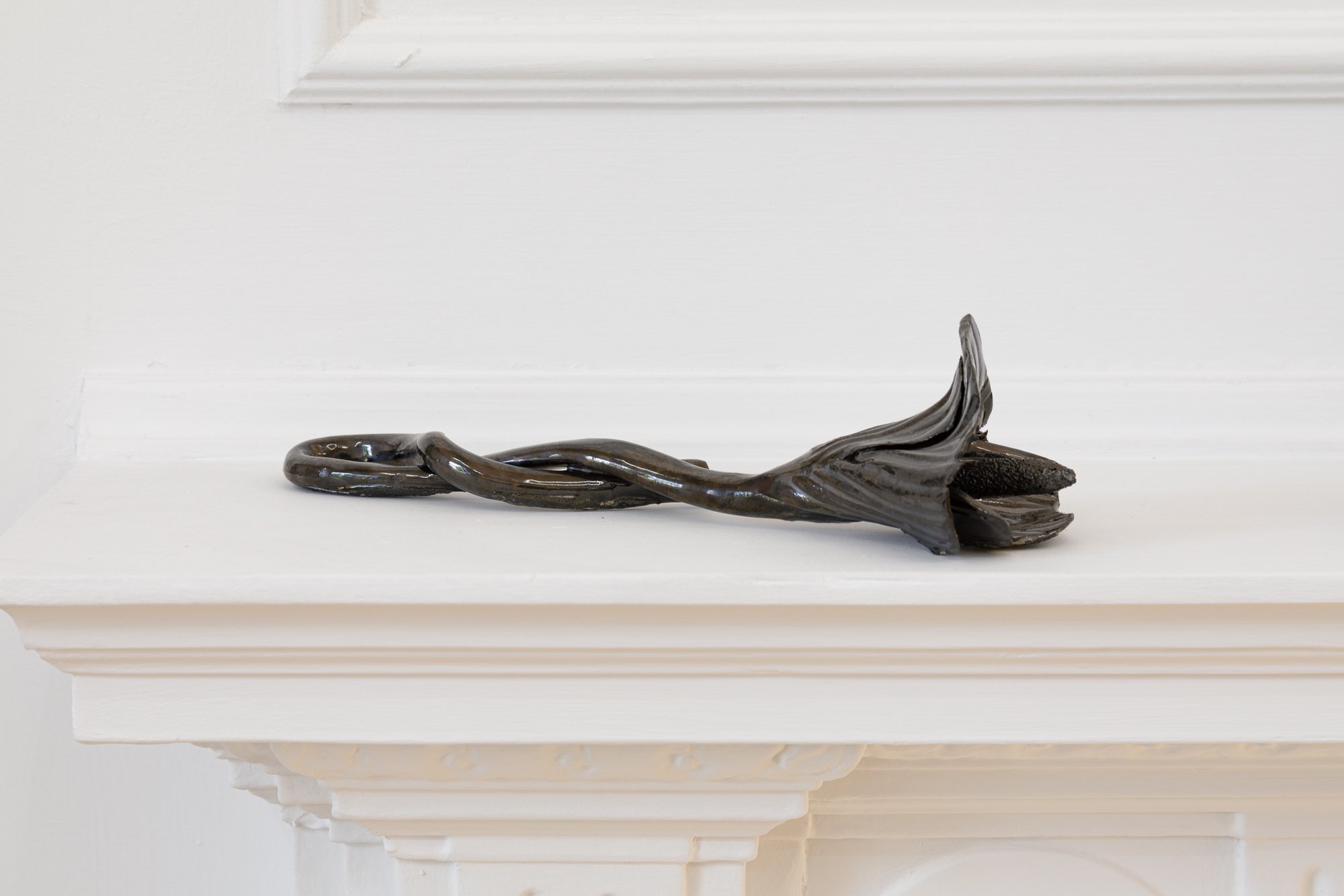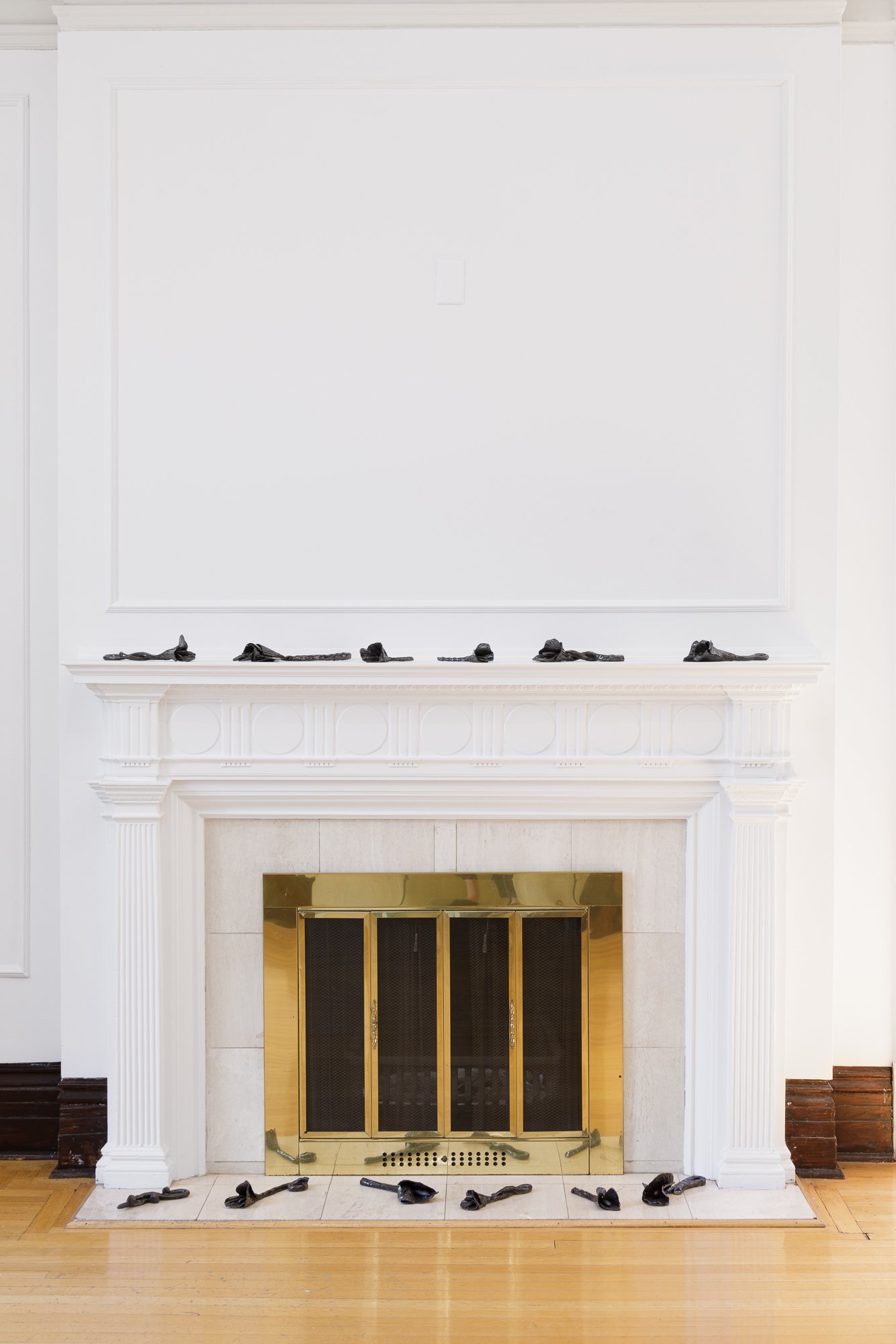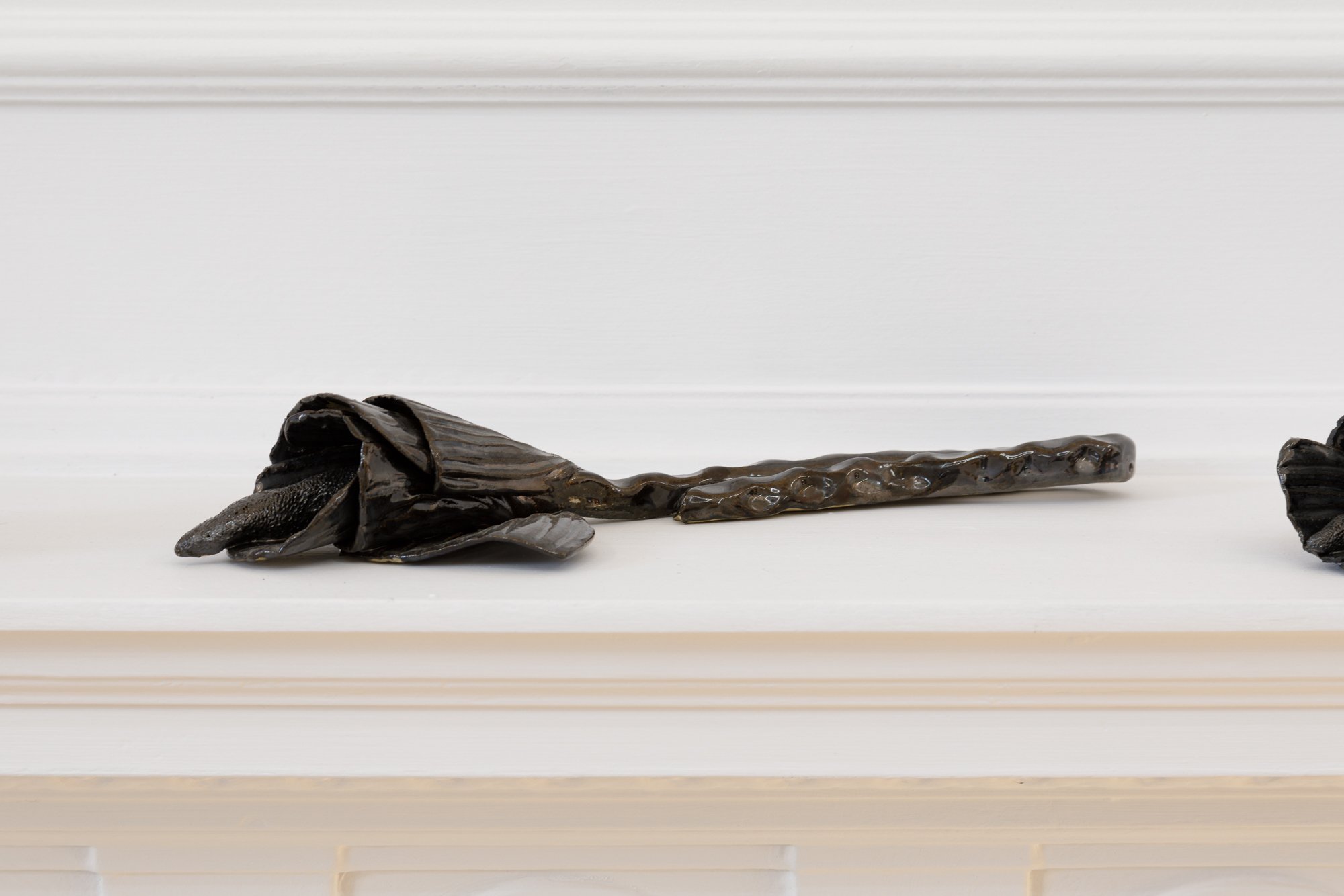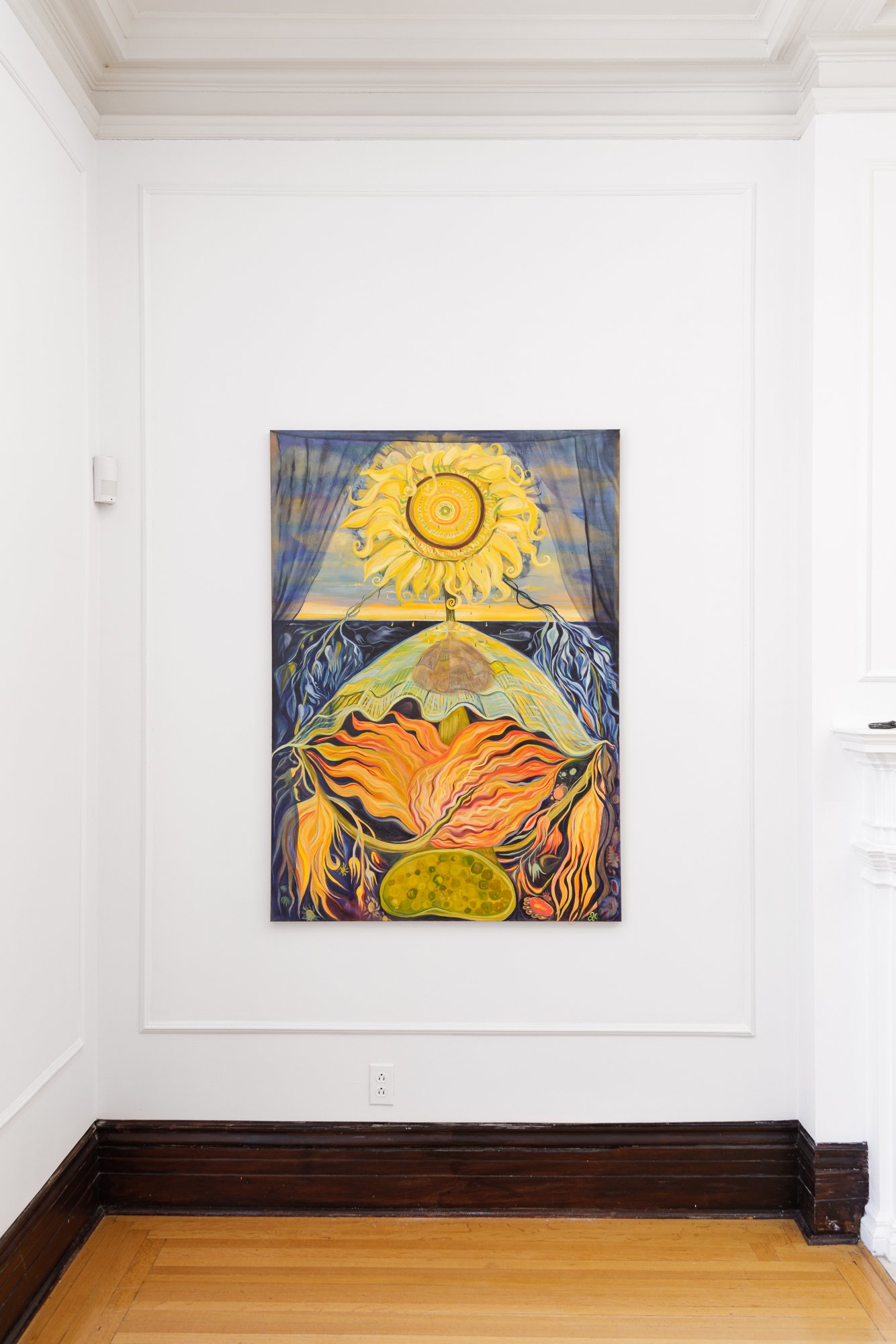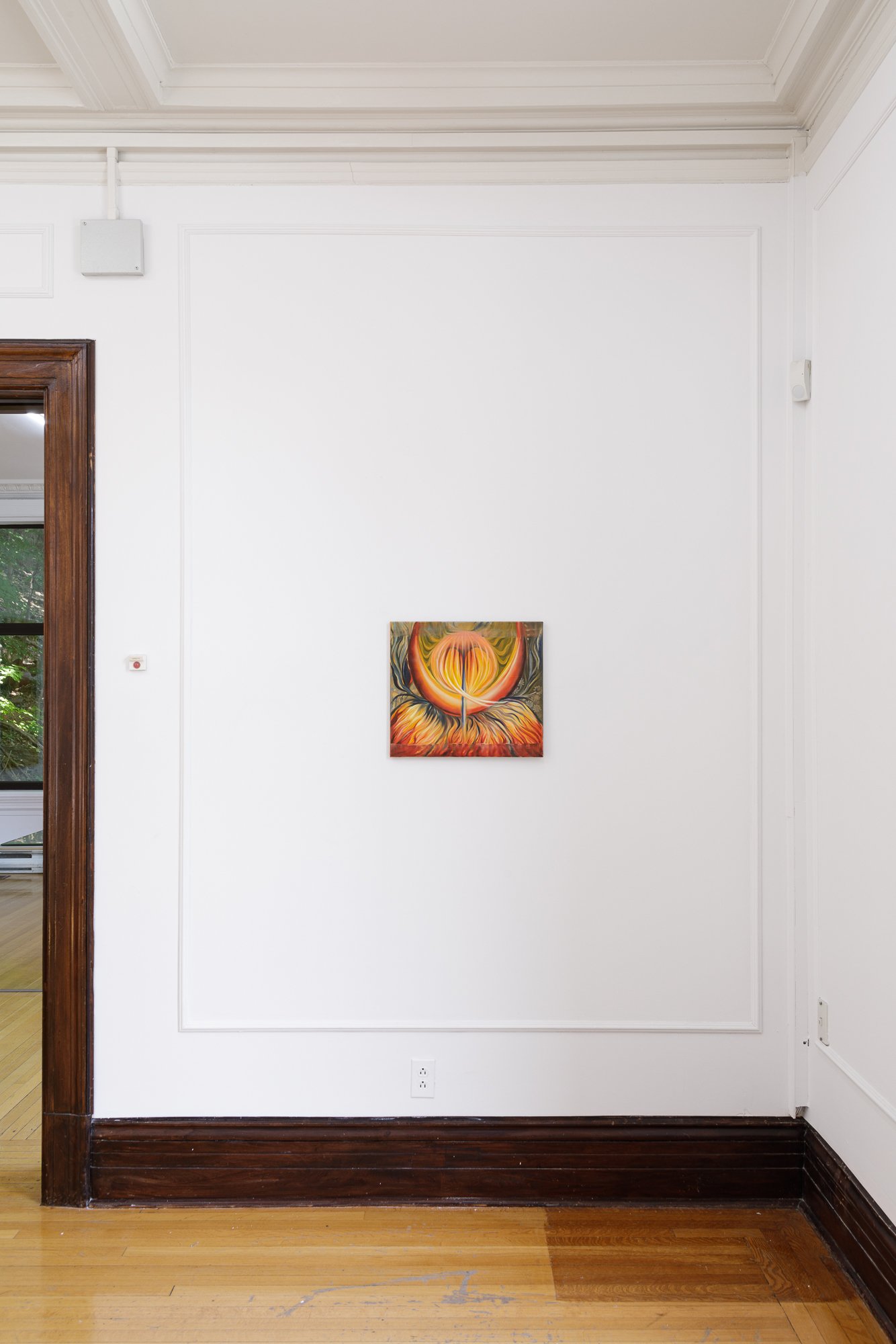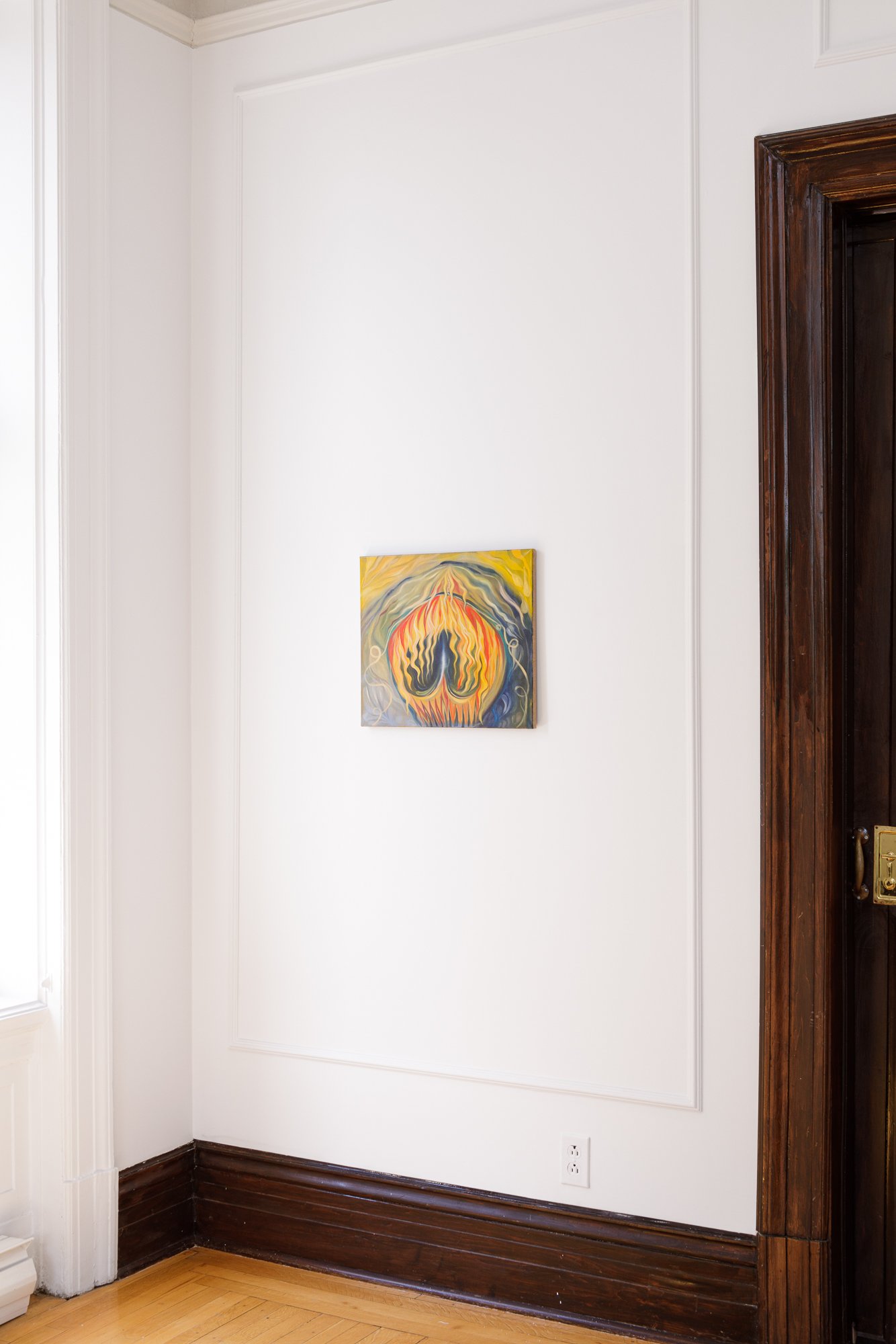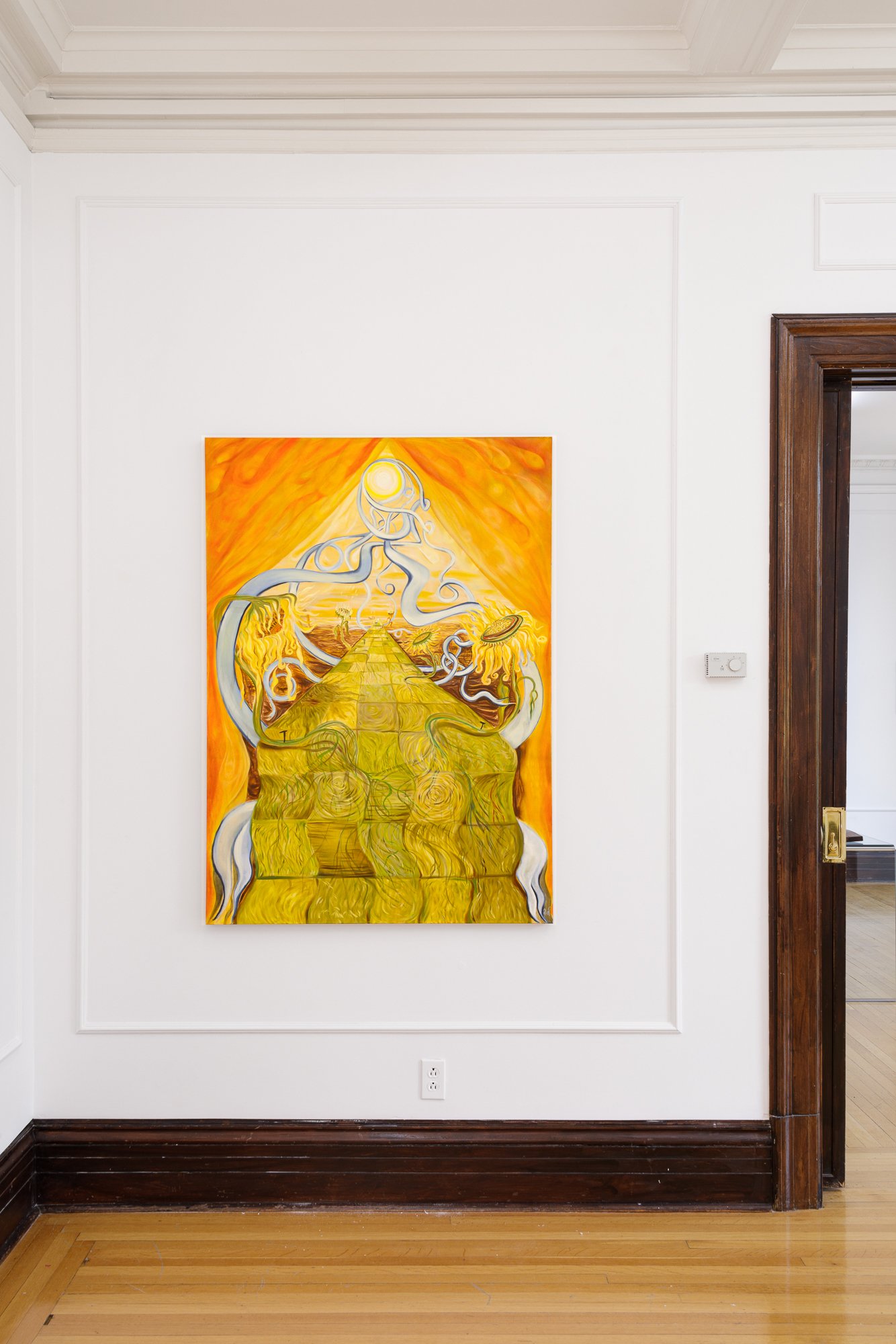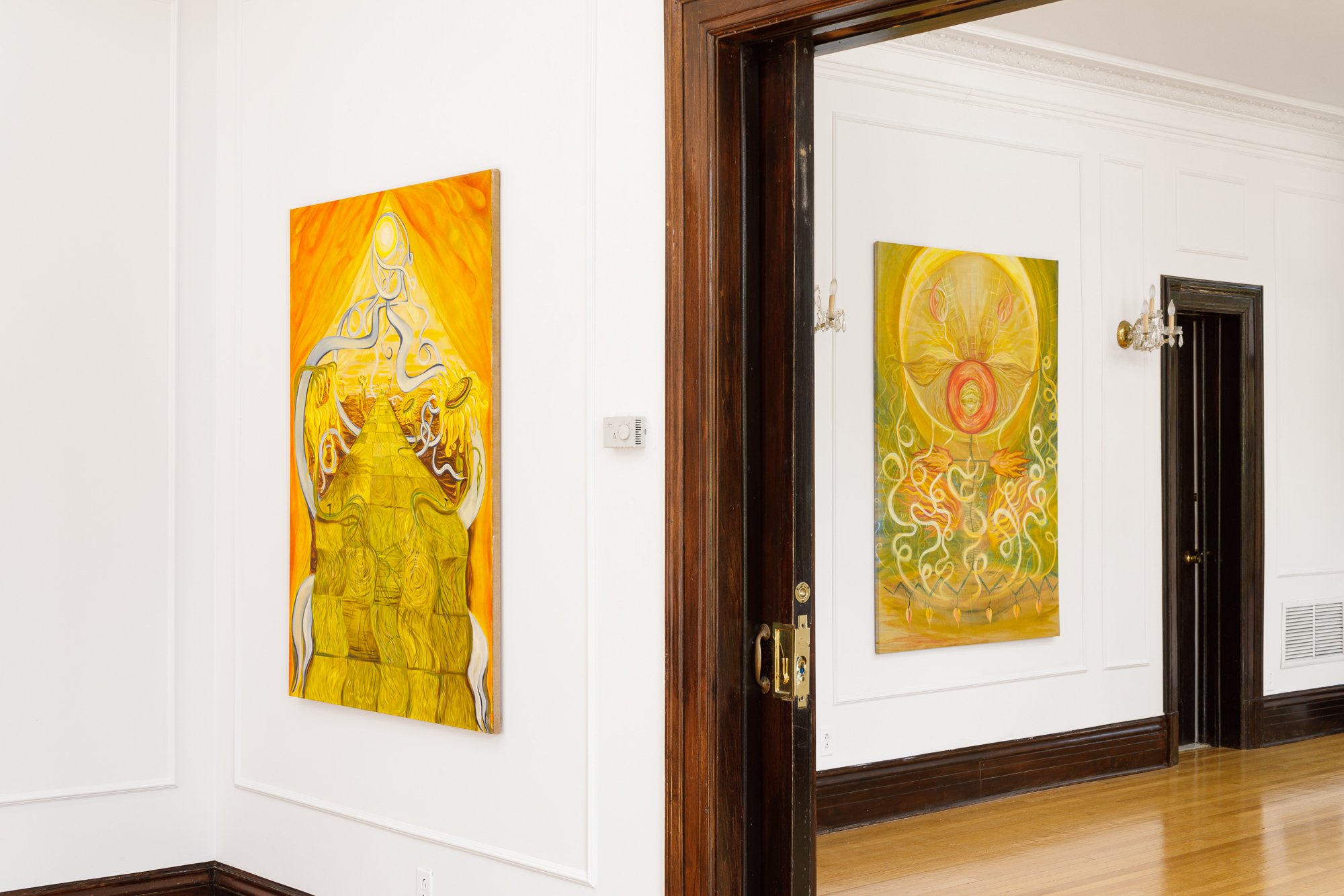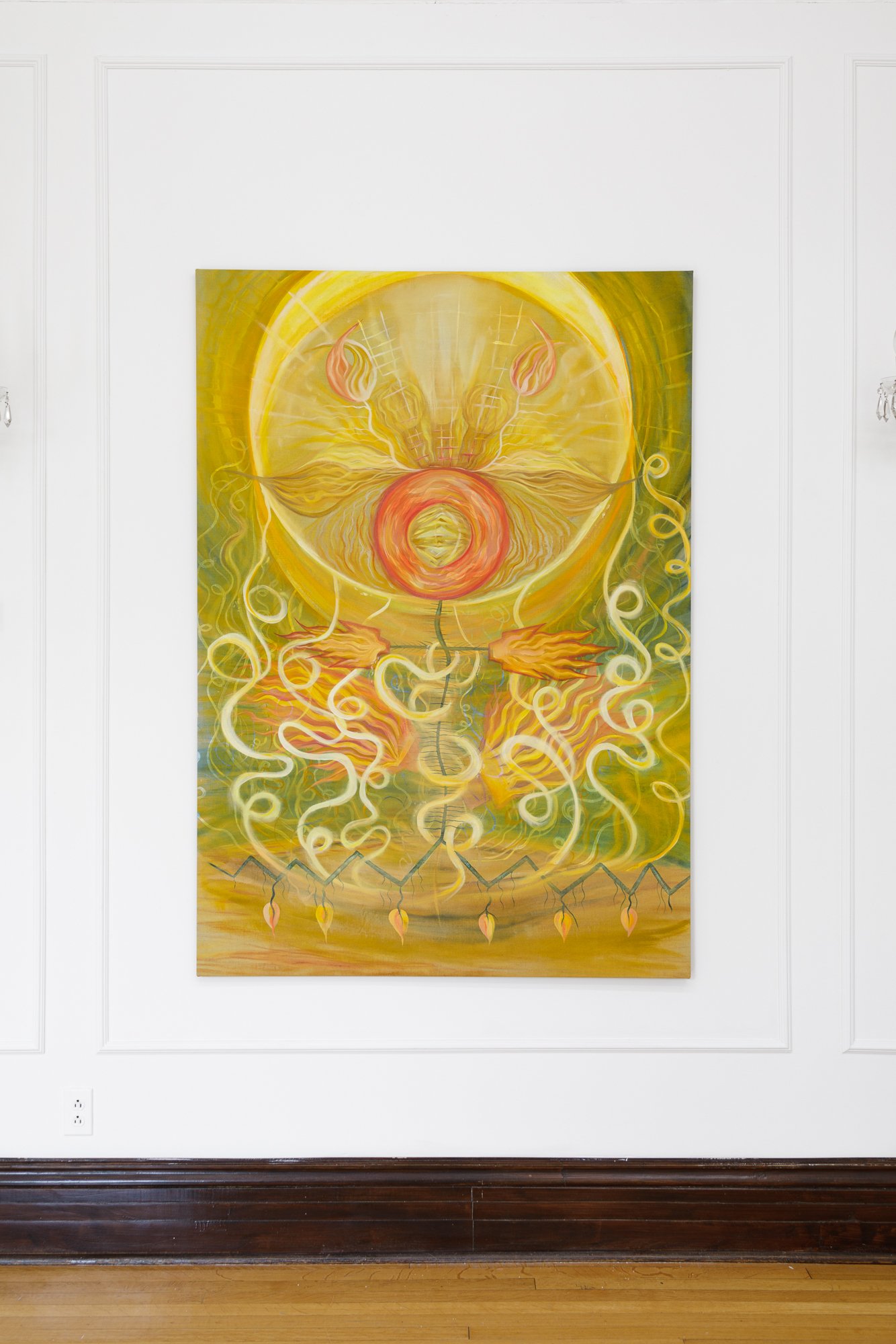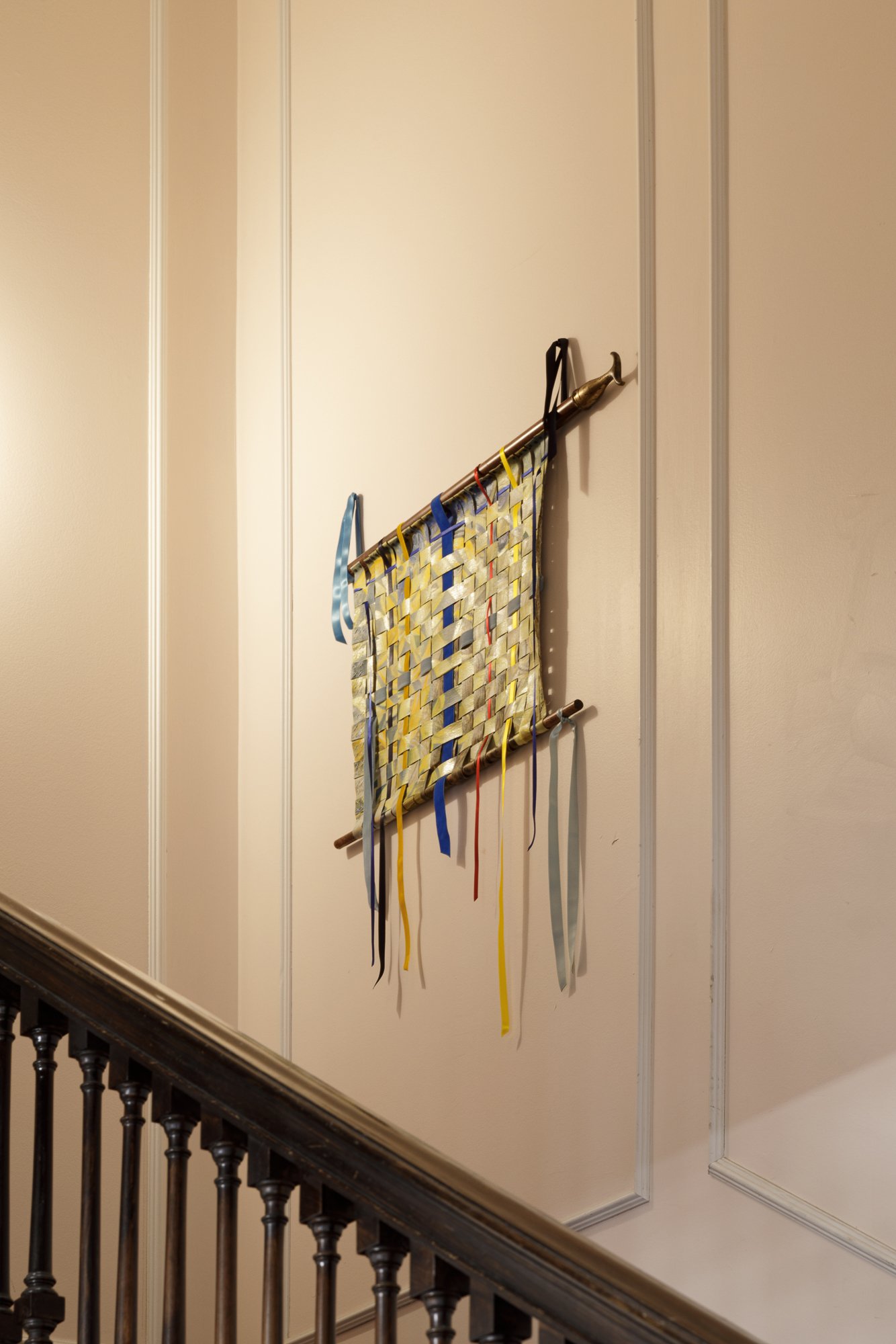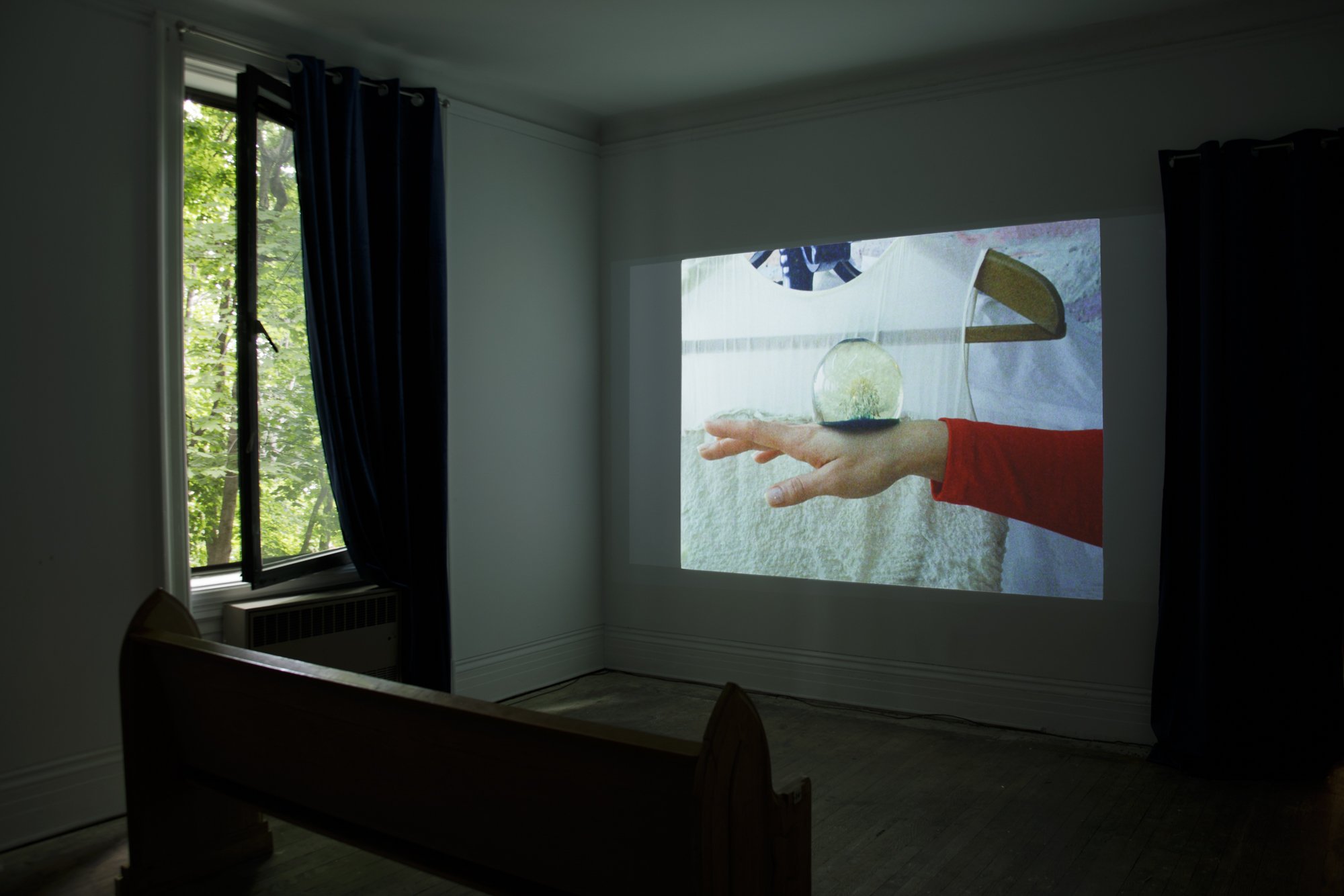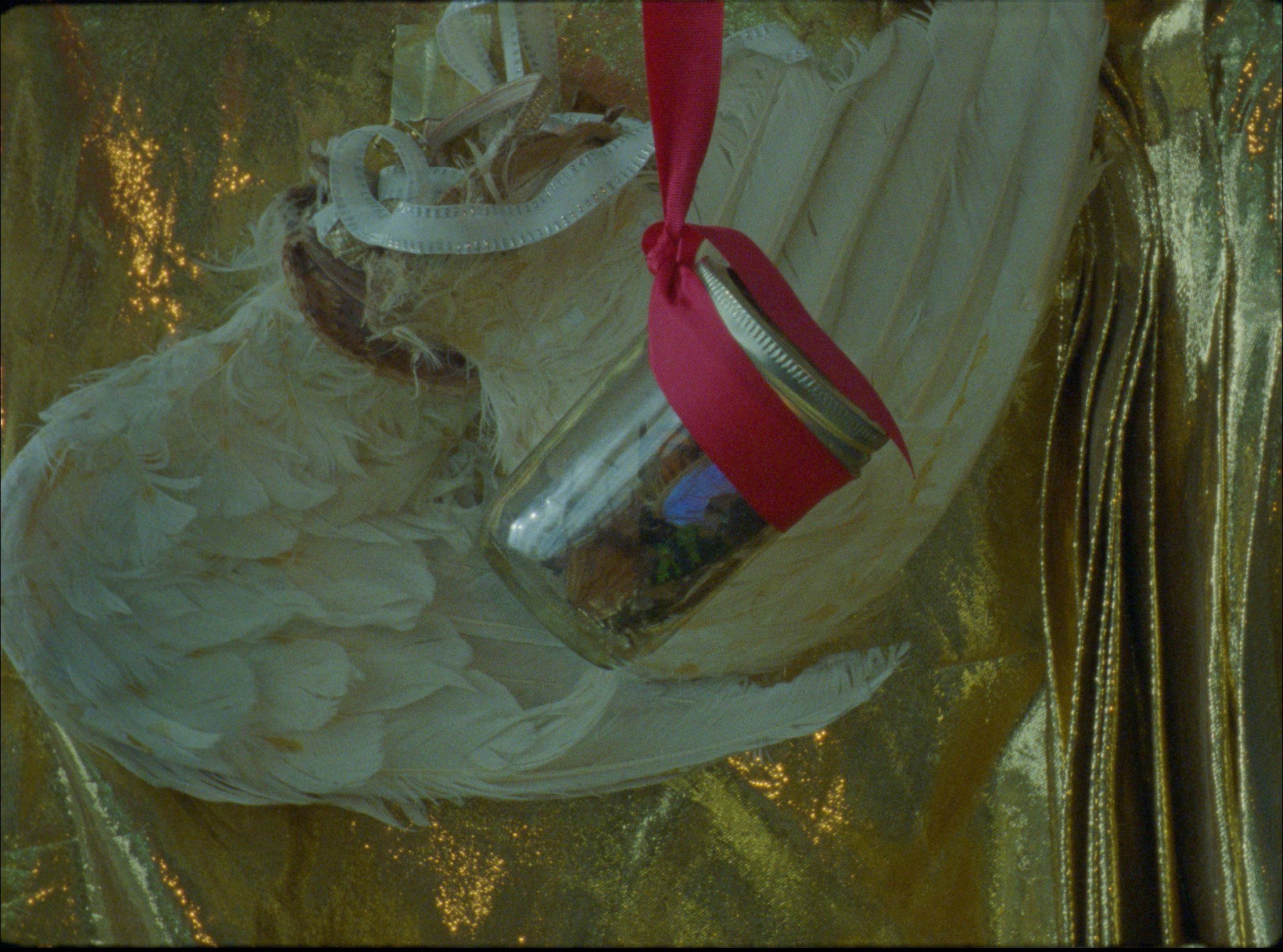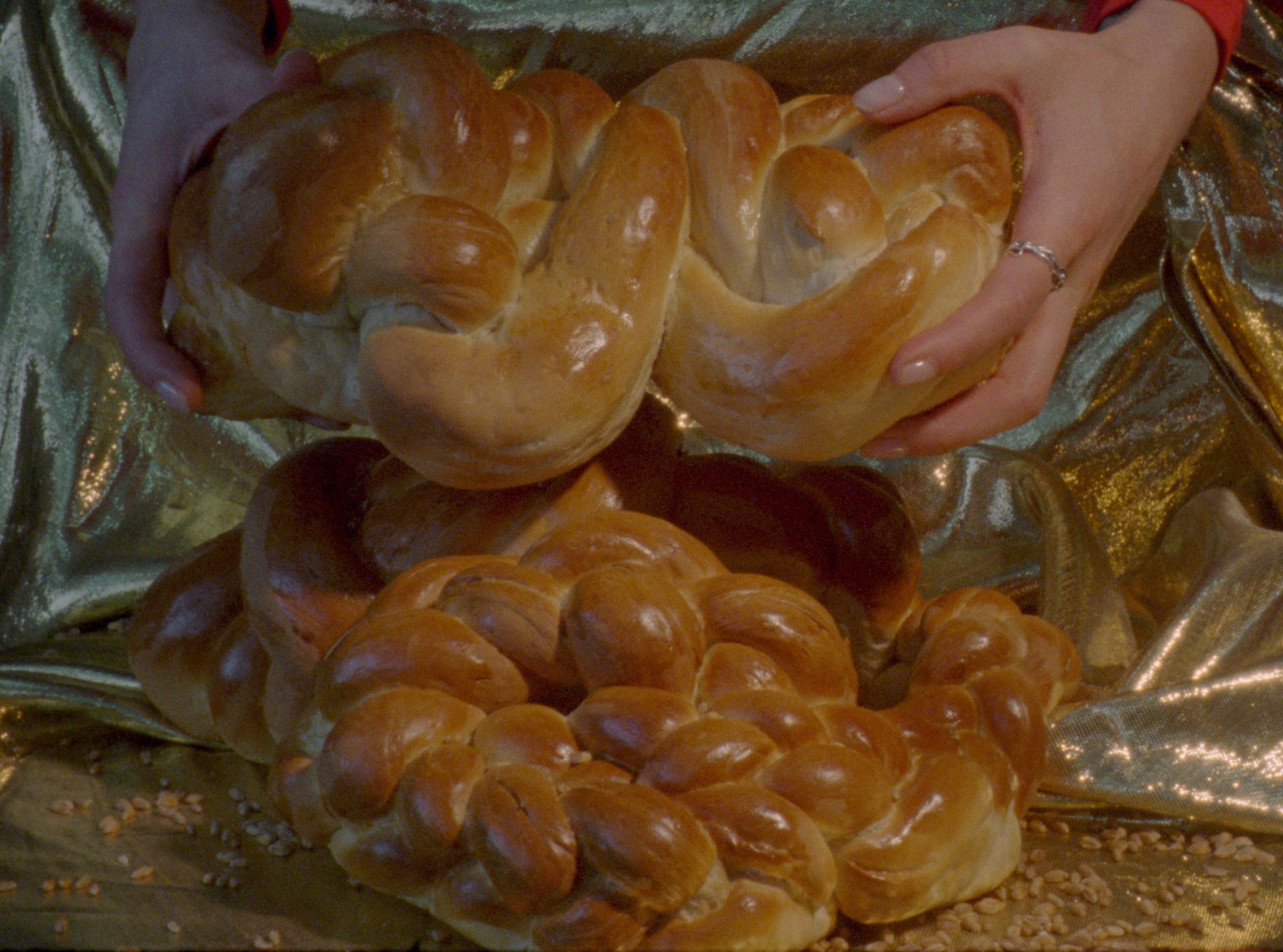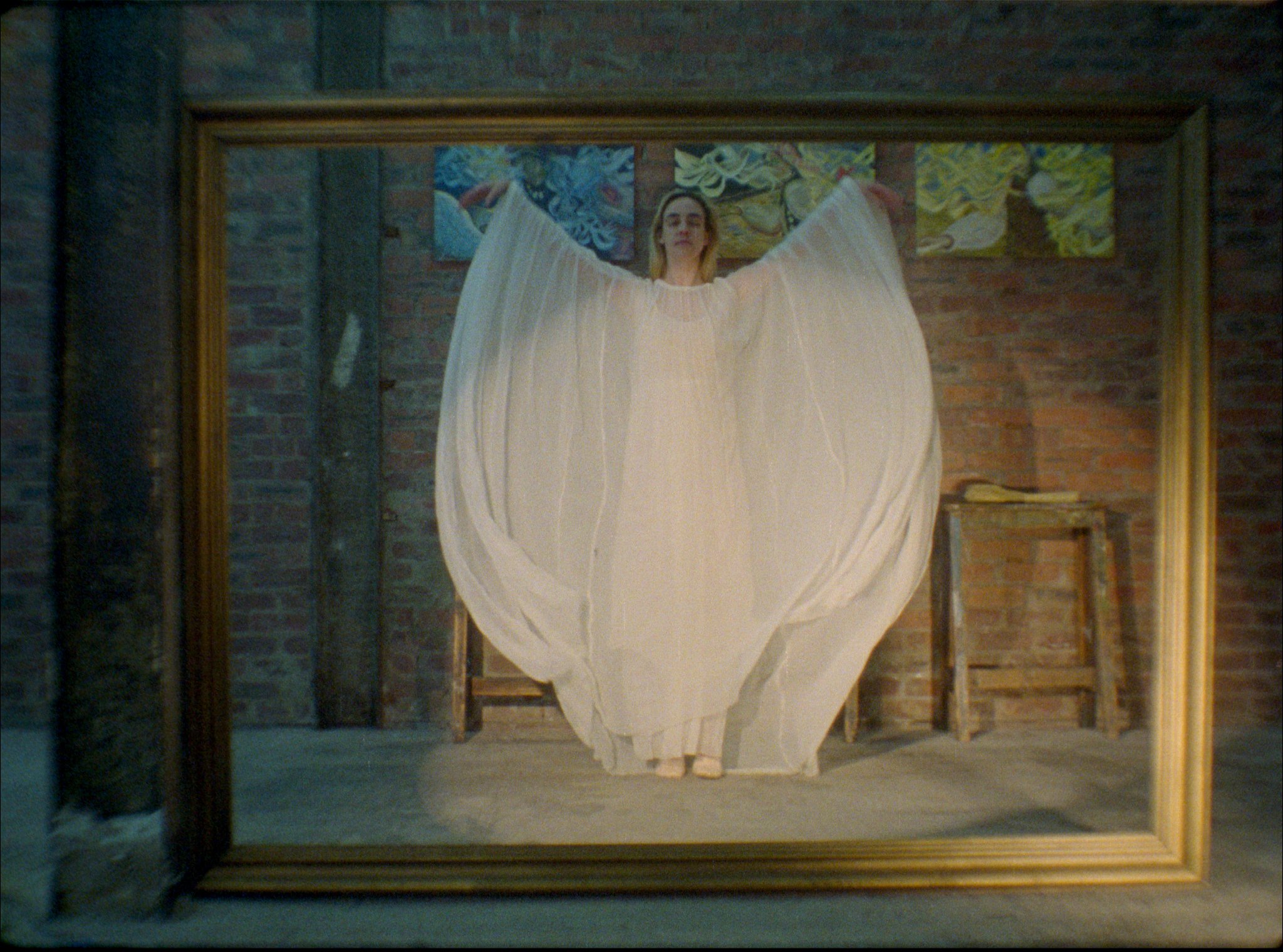Liberate Thee, Angel of History
Artist : Ayla Dmyterko
Dates: June 3 - July 15, 2023
Opening : Saturday, June 3, 4–7 pm (artist in attendance)
Venue : Pangée, 1305 ave des Pins O., Montreal
-
Liberate Thee, Angel of History
“Never regret thy fall, O Sophia of the fearless flight, for the greatest tragedy of them all, is never to feel the burning light.” – author unknown
The Angelus Novus (New Angel) is a 1920 oil transfer monoprint by Paul Klee. It depicts an angel transfixed in the static nature of the image. They are trapped in a longing gaze to the past, while their wings attempt to propel them forward. Like Icarus’ grand yet inadequate wings, they are bound together with earthly substance – by oil, by wax. In Liberate Thee, Angel of History, Ayla Dmyterko coaxes the angel of history to liberate itself from this medial state – to come into presence. Transposing the angel, she embodies its lessons in the exhibition’s large-scale fantastical compositions, chromatic abstractions, woven paintings, and moving image work.
Philosopher and critical theorist Walter Benjamin felt a mystical identification with the Angelus Novus as well and incorporated it into his theory of the “angel of history,” which critiques eternalizing the past as a continuum of progress. Saved by Hannah Arendt, it was written during the Second World War in an effort to make sense of the global downward spiral. Dmyterko applies this sentiment to reflect upon our turbulent present, relating it to Svetlana Boym’s The Future of Nostalgia (2001). Boym distinguishes two varying approaches to the past: restorative and reflective nostalgia. Both rely on similar triggers of memory and symbolic coding. They diverge, however, in task, narration, and intention. Embracing sensitivity within archival and familial research, Dmyterko considers history as forever shifting, eternally recurring, and warping across perspectives. The core of her practice is most interested in how to ethically look to the past, to the margins of history, and how to bring this into the present, in hope of a less destabilizing future.
In an alternative rhythm to the age of accelerated images and information, Dmyterko offers viewers spaces to remain present in colour, form, and fantasy. As colour sits on the outer edges of language and definition, so does silence and meditation, which quietly echo throughout these works. Drawing upon lineages of abstraction, colour theory, and surrealism, her auto-theoretical impulse extends to include the academicized alongside the vernacular, pre-patriarchal, fictional, tacit, folkloric, and anachronistic. This wide scope weaves lessons in meditation through repetition in nature, therapeutic qualities latent in folkloric textiles, eternally recurring symbolism, and the importance of community. She is inspired by painter Agnes Martin’s “On the Perfection Underlying Life” (1973) that describes freedom as “idyllic memories of perfection,” which can be contemplated through painting. This approach is similar to how embroidery work is practiced in Ukrainian culture, where only the clearest mind is thought to inspire pareidolic patterning, weaving emotions into the cloth that are carried with it. This belief is one that Dmyterko transfers to her painting practice, setting the tone for freedom through soft contemplation. In Liberate Thee, Angel of History, Dmyterko questions present-tense subjectivity while looking at the past and asks how futurisms can offer alternative formats, allowing our wings to carry us forward.
Text by Ayla Dmyterko
Edited Clara Puton -
Ayla Dmyterko (she/her) is a Ukrainian-Canadian artist currently based in Glasgow, Scotland. Echoing the fragmentary and porous nature of diasporic imagination, her interdisciplinary practice weaves together remedial forms of painting, moving image, dance, sculpture, textiles and texts. Echoing the porous and fragmentary nature of diasporic imagination, her interdisciplinary practice traces articulations of freedom in archival silences and expanded fields. This iterates across remedial forms of oil painting, moving image, dance, sculpture, textiles and texts. By reactivating and re-embodying cultural memory, poetics of precarity and dissonance emerge, exposing how traditions exist amidst new iterations of congregations in an animist world. Led by solastalgia, Dmyterko seeks slower paces in response to late capitalist rhythms. This allows me to both absorb and absolve the acceleration of images and information. Embracing ‘hysteria’ and its altered states, she examines spectres of eternal recurrence to understand ways that images and artists are mediums. Drawing upon lineages of abstraction, colour theory and surrealism, her cyrillist articulations include what is vernacular, pre-patriarchal, fictional, tacit, folkloric, and anachronistic. Through this bricolage approach, she disintegrates hierarchies of knowledge, canonical interpretations of art history and forms of artistic labour.
Solo exhibitions include “Vyshyvani Kazky, Embroidered Stories,” presented at Zalucky Contemporary (Toronto); “POUR THE FEAR: Solastalgic Synchronicities,” at Lunchtime Gallery (Glasgow); “Solastalgic Inheritance” at the Goethe Institute (Glasgow) and “The Tale Began with a Beet (It Must End with The Devil),” and Pangée’s (Montreal) first ever exhibition. Recent group exhibitions and screenings have been with VITRINE Gallery (London, UK & Basel, CH), Royal Scottish Academy (UK), 5 Florence Street (Glasgow, UK), CCA Glasgow (UK), Art Gallery of Regina (CA), Mourning School (Stockholm, CHE), Alchemy Film Festival (Hawick, UK); forthcoming with Bosse & Baum (London, UK) and David Dale Gallery (Glasgow, UK).
-
❧ Written, Directed, & Produced by Ayla Dmyterko
❧ Composition by Miel
❧ Director of 16mm Photography Alex Hetherington
❧ Dancer Kirstin Halliday
❧ Supported by Creative Scotland & Pangée 16mm processing by Kodak Film Labs LondonOn Volya: Filling in the Frescoes (2023) is a postcript to Kyiv Frescoes (1966) by filmmaker Sergei Parajanov (1924-1990). His film was conceived of as part of an “industry-wide effort to commemorate the 20th anniversary of the Soviet Union’s victory” in the Second World War. Kyiv Frescoes heralded Parajanov’s “surrealist and balletic style that would become the director’s signature,” as seen in his later masterpiece Colour of Pomegranates (1969). Kyiv Frescoes was deemed pacifist, provoking an anti-war message, and was furthermore critiqued as semi-autobiographical, resulting in its suppression by Goskino, the central state film committee in Moscow. During Glasnost or the Soviet Thaw (1986–1991), a period that saw intentional efforts towards institutional transparency and freedom of information, 15 minutes of remaining rushes were re-discovered in a film canister labelled “Diploma Film.” On Volya imagines the unearthing of a second.
Central to this moving image work is a meditation on the proto-slavic term: воля (volya), a lexical lacuna that describes the will and desire to exist beyond societal constructs; to be wildly emancipated. A slippery term, volya is described by Russian mystic writer Nadezhda Teffi (1872-1952) in her recently translated text Other Worlds: Peasants, Pilgrims, Spirits, Saints. Teffi chronicles Liberté as a person who finishes work early, takes their hat off and is free to read the newspaper; to sit and think in the café. They are free because they have abided by the rules of society. In contrast, Teffi describes Volya as a person who takes their hat off and runs into the field, blinded by the sun as they enter into an unbroken horizon. In On Volya’s opening scene, a figure appears to float through a forest; a guise that requires being high on the toes, with knees bent and stuck together; the hips and torso unnaturally controlled. It is anything but freeing. In the following shot, the figure escapes this muscle memory in a literal attempt to volya as she runs into the remains of the ancient Caledonian Forest. The film begins in an acknowledgement that volya itself, to flee into an unbroken horizon, the densest of forests, leaves one in solitude.
On Volya considers reverence and regeneration across social, political, and spiritual planes. It punctures idyllic façades of an eternally abundant nature, revealing how this ethos perpetuates the accelerated decline of our ecosystems today. If volya is indulged in sparingly, it is an essential space for rest, articulation, slowing down, and regaining the energy that can bolster reflective action. The film’s supernal crescendo depicts one such space by ascending the horizon and entering into a blue sky. It is the blue of Chernobyl’s velvety glow; Natalka Husar’s tubes of toxic Glasnost-market cobalt; Derek Jarman’s last words; Chantal Akerman’s From the East; Kandinsky’s symphonic ecstasy. It is the elation of altitude, the raging sea, morpho’s span, lover’s eyes.
Blue is a loss of consciousness,
a sense of self,
it is falling
– but which way is up?Revisiting Parajanov’s Kyiv Frescoes at this particular time is especially poignant as it sheds light on cyclical attempts to erase Ukrainian culture, occurring again today in the Russo-Ukrainian war. Working through a series of artistic interventions in On Voyla, what is missing is filled in with what is geographically available. The finale is a golden affair that draws parallels between the Fontaine Druzhba Narodov (Friendship of Nations Fountain) in Moscow, Russia and the Doulton Fountain in front of the People’s Palace in Glasgow, Scotland. On Volya: Filling in the Frescoes alters these symbols of soft power through an action led by ritual; the cleansing of assimilation. Breaking the fourth wall, I invite you to do the same.
Text by Ayla Dmyterko
Edited by Clara PutonNote: All quoted descriptions are original words by the Dovzhenko Studios. This is where the negative of Kyiv Frescoes is housed today, in the Dovzhenko National Centre in Kyiv. The Centre is Ukraine’s largest film archive, which is at great risk as a consequence of the current Russian invasion.

